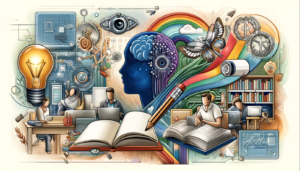English: Literature and Human Rights
(Important Question & Answers)
Download PDF Notes:–https://shorturl.at/E7tDX
Q. 1 Describe in detail the relationship of human rights with literature. How do they stir up each other? Explain with examples from the texts you have read.
Ans-
Relationship of human rights with literature
The relationship between human rights and literature is a deeply intertwined one. Literature often serves as a powerful medium to explore, critique, and promote human rights. Through stories, characters, and events, literature can bring attention to injustices, inspire empathy, and encourage readers to reflect on the moral and ethical treatment of others.
Similarly, human rights issues give literature a compelli ng purpose, as writers use their art to address inequalities, challenge societal norms, and advocate for justice.
ng purpose, as writers use their art to address inequalities, challenge societal norms, and advocate for justice.
Similarly, human rights issues give literature a compelling purpose, as writers use their art to address inequalities, challenge societal norms, and advocate for justice.
How Literature and Human Rights Stir Each Other
- Literature Gives a Voice to Human Rights Issues: Writers often highlight human rights violations by weaving them into their stories. This makes abstract or distant concepts more tangible and emotionally impactful for readers.
- Human Rights Inspire Literature: Real-life struggles for equality and justice often inspire authors to create stories that reflect these themes, helping to document and preserve these struggles for future generations.
- Encouraging Empathy and Change: Literature encourages readers to step into the shoes of others, understand their struggles, and feel compassion. This emotional connection can inspire action and promote awareness of human rights issues.
- Providing a Moral Framework: Human rights principles can provide a moral framework for authors to explore themes of justice, equality, and human dignity.
- Inspiring Narrative: Real-world human rights struggles can inspire authors to create fictional narratives that resonate with readers.
Example: To Kill a Mockingbird
Harper Lee’s To Kill a Mockingbird is a powerful example of how literature can illuminate human rights issues. The novel exposes the racial injustice and prejudice prevalent in 1930s Alabama. Through the eyes of young Scout Finch, readers witness the unfair treatment of Black people, particularly Tom Robinson, who is falsely accused of a crime.
- Racial Discrimination: The novel highlights the systemic racism that permeates Maycomb society, from the segregated schools to the biased legal system.
- The Right to a Fair Trial: Atticus Finch’s defense of Tom Robinson underscores the importance of due process and the right to a fair trial.
- The Right to Equality: The novel challenges the notion of racial superiority and advocates for equality and justice for all.
Conclusion
In conclusion, literature and human rights are deeply intertwined. Literature can be a powerful tool for promoting human rights by raising awareness, fostering empathy, and inspiring action. Conversely, human rights principles can inspire authors to create compelling narratives that challenge injustice and promote social change.
Q. 2 How does literature help in understanding and confronting human rights violations?
Ans- Introduction
Literature is a powerful way to understand and confront human rights violations. Through stories, it shows us the live s and struggles of people affected by injustice, helping us to feel their pain and see the world from their perspective. This emotional connection makes human rights issues more real and personal.
s and struggles of people affected by injustice, helping us to feel their pain and see the world from their perspective. This emotional connection makes human rights issues more real and personal.
How Literature Helps
- Creates Awareness: Literature tells us about injustices we might not know about. For example, books about slavery, war, or inequality show the suffering caused by these problems. Stories help readers see the effects of oppression and discrimination in ways that facts alone cannot.
- Builds Empathy: By stepping into the shoes of characters, we understand their feelings and struggles. This builds compassion and encourages us to care about human rights.
- Inspires Action: Literature can motivate people to stand up against injustice. When we see characters fighting for their rights, it inspires us to do the same in real life.
- Challenges Society: Writers often use their work to criticize unfair systems or laws. These stories can make readers question the way things are and imagine a fairer, better world.
Examples
To Kill a Mockingbird by Harper Lee: This book shows the racism and unfair treatment of African Americans in the 1930s. Through Tom Robinson’s trial, readers understand how prejudice destroys justice and harms innocent people.
Conclusion
Literature connects us to human rights issues in a way that facts and statistics cannot. It helps us feel the pain of others, understand the importance of justice, and inspires us to create change. By reading these stories, we learn to confront violations and stand up for the dignity and rights of all people.